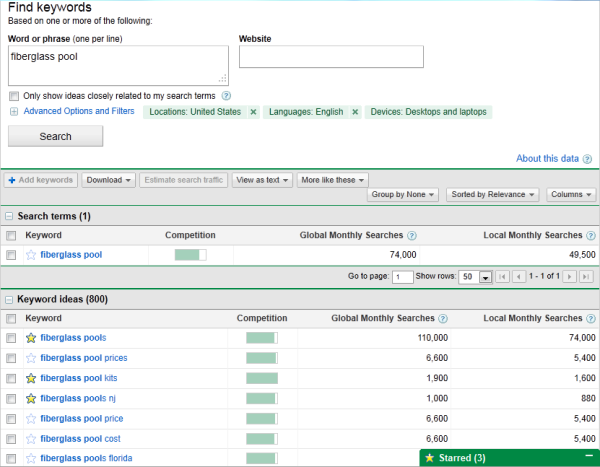How to Create an SEO Strategy for 2021 [Template Included]
Here's a cliche among digital marketers: search engine optimization (SEO) isn't what it used to be.
![How to Create an SEO Strategy for 2021 [Template Included]](https://blog.hubspot.com/hubfs/create-seo-strategy.jpg#keepProtocol)
Here's a cliche among digital marketers: search engine optimization (SEO) isn't what it used to be. Here's a true statement you don't hear as often: your SEO strategy for 2021 shouldn't focus on keywords. These days, most businesses understand the basic concepts of SEO and why it's important. However, when it comes to developing and executing a sound SEO strategy for your business, just creating content for the keywords your customers are searching for is both arduous and, well, wrong. In this post, we’ll explain what an SEO strategy is, and how you create your own to help you meet your content marketing goals. An SEO strategy is the process of organizing a website’s content by topic to improve the likelihood of appearing in search results. Essentially, it is the process you follow in order to maximize the opportunity to gain organic traffic from search engines. Having an SEO strategy is important because it helps you stay on track when creating content. Instead of just creating what you think people are looking for, your strategy will ensure that you’re creating content that people are searching for. For content marketing, an SEO strategy is a critical piece of the puzzle because it is how your content will come to be seen in the first place, especially in search engine result pages (SERPs). If your content is scattered and unorganized, search engine bots will have a harder time indexing your site, identifying your area of authority, and ranking your site pages. Mobile SEO is an important factor to keep in mind when creating your overall strategy. Mobile optimization involves ensuring your site and site content is available and accessible to visitors on mobile devices, so they can have the same experience and receive the same value as desktop browsers. Mobile optimization is incredibly important, as Google practices mobile-first indexing. This means instead of crawling a desktop site, the algorithm will use the mobile version of your site when indexing and ranking pages for SERPs. In addition, 61% of Google search queries in the U.S. occur on mobile devices. So, all things considered, your SEO strategy would be ineffective without prioritizing mobile optimization. While it’s not an entirely separate process, there are distinct considerations for mobile SEO like monitoring page speed, responsive site design, local SEO, and creating content that is high-quality, regardless of device it’s viewed on. Search engine optimizers (SEOs) are people who optimize websites to help them rank higher on SERPs and gain more organic traffic. In essence, an SEO is a highly specialized content strategist that helps a business discover opportunities to answer questions people have about their respective industries. There are three types of SEO that an SEO strategist can focus on: Bear in mind that every business has different objectives, so it is an SEO’s job to examine their industry, determine what their audiences care about, and develop a strategy that gives them what they’re looking for. Below we’ll go over some steps you can take to ensure your SEO strategy sets you up for success. Keywords are at the heart of SEO, but they're no longer the first step to achieving organic growth. Instead, the first step is to make a list of topics you’d like your content to address. To start, compile a list of about 10 words and terms associated with your product or service. Use an SEO tool ( Google's Keyword Tool, Ahrefs , SEMRush or GrowthBar just to name a few) to research these words, identify their search volume, and come up with variations that make sense for your business. By doing this, you are associating these topics with popular short-tail keywords, but you’re not dedicating individual blog posts to these keywords. Let’s go over an example of this process using the image below. Let’s say a swimming pool business is trying to rank for “fiberglass pools,” which receives 110,000 searches per month. This short-tail keyword can represent the overarching topic for creating their content, but the business will also need to identify a series of related keywords to include in their content. For example, they could opt to use the “fiberglass pool prices,” or “fiberglass pool cost,” to achieve additional rankings for the overall keyword of fiberglass pools. Using search volume and competition as your measurement, you can create a list of 10-15 short-tail keywords that are relevant to your business and are being searched for by your target audiences. Then, rank this list based on monthly search volume. Each of the keywords that you’ve identified are called pillars, and they serve as the primary support for a larger cluster of long-tail keywords, which we’ll discuss below. During this step you’ll begin optimizing your pages for specific keywords. For each pillar you've identified, use your keyword tool to identify five to 10 long-tail keywords that dig deeper into the original topic keyword. For example, we regularly create content about SEO, but it's difficult to rank well on Google for such a popular topic with this acronym alone. We also risk competing with our own content by creating multiple pages that are all targeting the exact same keyword — and potentially the same SERPs. Therefore, we also create content on conducting keyword research, optimizing images for search engines, creating an SEO strategy (which you're reading right now), and other subtopics within the SEO umbrella. This helps businesses attract people who have varying interests and concerns — and ultimately create more entry points for people interested in what you have to offer. Use your long-tail keywords to create blog posts or web pages that explain the specific topics within the pillars you’ve selected. Together, all of your long-tail keywords create a cluster around a pillar topic. Search engine algorithms depend on the relationships between clusters to connect users with the information they're looking for. Here's a short video on this concept: Think of it this way: the more specific your content, the more specific the needs of your audience can be, and the more likely you'll convert this traffic into leads. This is how Google finds value in the websites it crawls — the pages that dig into the inner workings of a general topic are seen as the best answer to a person's query, and will rank higher. When it comes to websites and ranking in search engines, trying to get one page to rank for a handful of keywords can be next to impossible. But, here's where the rubber meets the road. Use the pillar topics you came up with to create a page or post that gives a high-level overview of the topic using the long-tail keywords you came up with for each cluster in step two. These pillar pages can essentially be a table of contents, where you’re giving a description of the main topic, and briefing readers on subtopics you’ll elaborate on in other posts. Ultimately, the number of topics for which you create pillar pages should coincide with your business needs, like the number of products and offerings you have. This will make it much easier for your prospects and customers to find you in search engines no matter what keywords they use. Blogging can be an incredible way to rank for keywords and engage your website's users. After all, every blog post is a new web page and an additional opportunity to rank in SERPs. If your business does not already have a blog, consider creating one. As you write each blog post and expand on your clusters, you should do three things: Every blog post or web page you create doesn’t necessarily need to belong to a topic cluster. There's also value in writing about tangential topics your customers care about to build authority with the Google algorithms. With that in mind, make it a point to blog at least once a week. Remember, you are blogging primarily for your audience, not search engines, so study your target market and write about things that they are interested in. It may be helpful to create a content strategy to remain consistent and focused on your goals. The topic cluster model is your way forward in SEO, but it's not the only way to get your website content to rank higher once it's been created. While our first five steps were dedicated to on-page SEO, link-building is the primary objective of off-page SEO. Link-building is the process of attracting inbound links (also called backlinks) to your website from other sources on the internet. As a general rule, sites with more authority that link back to your content have a more significant impact on your rankings. Dedicate some time to brainstorming all the various ways you can attract inbound links. Maybe you’ll start by sharing links with local businesses in exchange for links to their own sites, or you’ll write a few blog posts and share them on different social media platforms. You can also approach other blogs for guest blogging opportunities through which you can link back to your website. This is a small but important step in the SEO process, especially for mobile optimization. As your blog or website grows, you'll undoubtedly have more images, videos, and related media to support your content. These visual assets help retain your visitors' attention, but it's easy to forget that these files can be very large. Since page speed is a crucial ranking factor, it’s important to monitor the size of the media files you upload to your site. The bigger the file size, the more difficult it is for an internet browser to render your website. It’s also harder for mobile browsers to load these images, as the bandwidth on their devices is significantly smaller. So, the smaller the file size, the faster your website will load. But, how do you compress images and still retain quality? Just like marketing, the search engine landscape is ever-evolving. Staying on top of current trends and best practices is an important strategy, and there are multiple online resources that can help you do so. Here are a few resources to check out: SEO can take a lot of time and effort, and, because of this, you’ll want to know if your strategy works. It’s important to track your metrics to understand the success of your overall process, and identify possible areas for improvement. You can monitor organic traffic using your preferred web analytics tool or create your own dashboard using Excel or Google Sheets. Also, tracking indexed pages, conversions, ROI, and your rankings on SERPs can help you recognize your success as well as identify areas of opportunity. Once you’ve created your SEO strategy, you should also build a process to continue optimizing for new keywords and evolving search intent. Here are a few steps you can take. Devote some time each month to updating old blog posts with new and up-to-date information to continue ranking in SERPs. You can also use this time to add any SEO best-practices that weren’t initially addressed, like missing image alt text. After a few months, track how your blog posts are ranking, and which keywords they're ranking for. This can help you adjust subheadings and copy to leverage new search intent that your audience may be interested in. Sometimes, you'll find that a post is completely out of date. In this scenario, you should go beyond the average historical SEO update and give it a full refresh. You can do this by updating out of date information and statistics, incorporating new sections for added depth, and adding quotes or original data to give the post more referral traffic. To keep up with your SEO strategy, it can be helpful to create and refine a monthly content plan. You can place it into a spreadsheet, and your teams can track accordingly. The list below is an example of a content monthly content plan that takes the above steps into account. With a monthly SEO plan like the one above, plus a tracking document like a search insights report, you can build out and execute on an efficient SEO strategy. You can also identify and leverage low-hanging-fruit topics to discuss related to your industry. Ranking in search pages can be difficult. While it may seem enticing to create content that is centered around high-traffic keywords, that strategy may not help you meet your business goals. Instead, opt to create an SEO strategy that helps you address your individual business needs, like increasing customer acquisition, for greater marketing success. To learn more about SEO, check out our Ultimate Guide to SEO. Editor's Note: This blog post was originally published in April 2019 but was updated in February 2020 for consistency and freshness.What is an SEO strategy?
Mobile SEO Strategy
What is an SEO?
SEO Content Strategy
1. Make a list of topics.

2. Make a list of long-tail keywords based on these topics.
3. Build pages for each topic.
4. Set up a blog.
5. Create a consistent blogging schedule.
6. Create a link-building plan.
7. Compress media files before uploading them to your site.
It’s worth considering the use of a compression tool to reduce file sizes before uploading images, videos, and gifs. Sites like TinyPNG compress images in bulk, while Google's Squoosh can shrink image files to microscopic sizes. However you choose to compress your media, keeping files in the kilobytes (KB) range is a good rule of thumb.8. Stay up-to-date on SEO news and best practices.
9. Measure and track your content's success.
SEO Process
1. Historically optimize your content.
2. Look out for changing keywords and new search intent.
3. Add more editorial value to your old content.
4. Create a monthly content plan.
SEO Monthly Plan
Create A Strategy That Supports Your Business Goals
Originally published Mar 8, 2021 7:00:00 AM, updated March 08 2021

 Konoly
Konoly ![SEO Starter Pack [Free Kit]](https://no-cache.hubspot.com/cta/default/53/1d7211ac-7b1b-4405-b940-54b8acedb26e.png)














![5 Reasons Why Brands Lose Followers on Instagram [HubSpot Blog Data]](https://blog.hubspot.com/hubfs/losing-followers-on-instagram.jpg#keepProtocol)


















